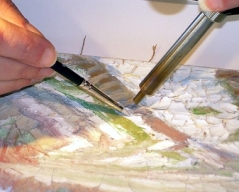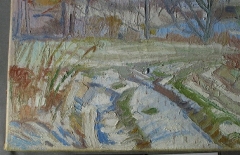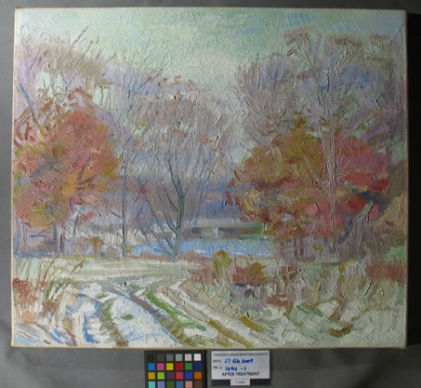By Kathryn Campbell, Assistant Paintings Conservator
(Above) The River Road – Early Snow by Albert Krehbiel; Before treatment, raking light
ALBERT HENRY KREHBIEL (1873-1945) (link) is an American artist known for his paintings of Chicago cityscapes, the rural Midwest, and brightly colored Santa Fe and Santa Monica landscapes. He studied at both the School of the Art Institute of Chicago and the Académie Julian in Paris where he received artistic acclaim and recognition. As a faculty member of the Art Institute of Chicago, he helped start the Chicago Art Institute Summer School of Painting (Ox-Bow), and also was a faculty member of the Illinois Institute of Technology. His paintings are located in many collections, including those of the Smithsonian Institution and the Art Institute of Chicago.
(Above) Before treatment, detail
The River Road – Early Snow (oil on canvas), pictured above, came to The Center because of lifting throughout the paint layer. Cracking and lifting of the paint layer occurs when stresses on the painting are too strong for the strength of the paint layer. These stresses, such as, environmental changes in heat and humidity, cause the paint, ground, and canvas layers to expand and contract at different rates resulting in cracks and lifting. Because the paint layer was friable, the already dry paint became more brittle than normal over time. (Definition below.)
Most deterioration problems of this nature can be helped with conservation treatment. The conservation adhesive BEVA 371 was chosen based on the solubility of the paint and the characteristics of the paint layer. The adhesive was carefully applied with a brush under binocular magnification. The paint layer and adhesive were then heated with a hot air tool to soften, and set down with pressure. (Definition below.)
Above left: Application of adhesive. Right: Setting down paint with hot air tool
After many hours of executing this technique under binocular magnification, the paint layer was securely bonded to the ground layer and the canvas. The losses where then filled and textured with Modostuc, carefully inpainted with Gamblin conservation paints, and the painting regained the cohesive appearance that the artist intended. (Definitions below.)
Above Left: Losses filled before inpainting (brighter white areas). Right: After treatment detail
Above: After treatment: Raking light
When dealing with condition issues such as flaking paint, it is important to address conservation treatment as early as possible to prevent further paint loss and structural damage. Stabilizing the paint layer and structural instabilities ensures that the integrity of the artwork will be protected from future deterioration, and allow future generations to enjoy Albert Krehbiel’s artistic message.
Terms and Definitions:
- BEVA 371: A non-aqueous heat seal adhesive developed by Gustav A. Berger of New York which is widely used for the lining of oil paintings, heat seal facings and the making of laminates with fiberglass, etc.
- Friable: Easily crumbled or broken; brittle.
- Gamblin Paints: A brand name for conservation paints that are stable, reversible and used in a wide array of painting styles and techniques. They are made with a low molecular weight resin binder making them safer to use.
- Modostuc: A brand name for the white paste used as fill material. It dries quickly to a hard smooth fill, and can be sanded and painted making it appropriate for filling losses during treatments.








